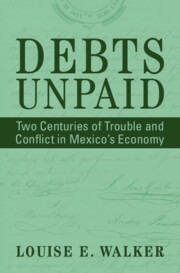Refine search
Actions for selected content:
616368 results in History
Index
-
- Book:
- From Frontiers to Borders
- Published online:
- 23 October 2025
- Print publication:
- 06 November 2025, pp 263-267
-
- Chapter
- Export citation
Copyright page
-
- Book:
- The Rise and Fall of Turkey's Democrat Party
- Published online:
- 23 October 2025
- Print publication:
- 06 November 2025, pp iv-iv
-
- Chapter
- Export citation
6 - Law and the Court of Wards
-
- Book:
- Institutional Change and Property Rights before the Industrial Revolution
- Published online:
- 23 October 2025
- Print publication:
- 06 November 2025, pp 150-165
-
- Chapter
- Export citation
Bibliography
-
- Book:
- Institutional Change and Property Rights before the Industrial Revolution
- Published online:
- 23 October 2025
- Print publication:
- 06 November 2025, pp 235-253
-
- Chapter
- Export citation
Tables and Figures
-
- Book:
- Institutional Change and Property Rights before the Industrial Revolution
- Published online:
- 23 October 2025
- Print publication:
- 06 November 2025, pp viii-viii
-
- Chapter
- Export citation
Food and Emotions in Italian Women’s Writing: A Reassessment by Patrizia Sambuco, Toronto/Buffalo/London, University of Toronto Press, 2024, xii + 206 pp., CA$70.00 (hardcover), ISBN 978-1-4875-0683-4
-
- Journal:
- Modern Italy , First View
- Published online by Cambridge University Press:
- 05 November 2025, pp. 1-3
-
- Article
- Export citation

The North Caucasian Kingdom of Alania, 850–1240
- Coming soon
-
- Expected online publication date:
- November 2025
- Print publication:
- 21 August 2025
-
- Book
- Export citation
Agathias’ Greek: sixth-century language through two case studies from the Histories
-
- Journal:
- Byzantine and Modern Greek Studies , First View
- Published online by Cambridge University Press:
- 05 November 2025, pp. 1-18
-
- Article
- Export citation
“Hints” of Sexual Violence: What the Akayesu Trial Archive at the International Criminal Tribunal for Rwanda Tells Us About Uncovering Sexual Violence Testimony in Conflict Archives
-
- Journal:
- Law and History Review , First View
- Published online by Cambridge University Press:
- 05 November 2025, pp. 1-22
-
- Article
-
- You have access
- Open access
- HTML
- Export citation
Erol Ülker , Istanbul at the Threshold of Nation State: Allied Occupation, National Resistance, and Political Conflict, 1918–1923. New York: Berghahn Books, 2024. 177 pages.
-
- Journal:
- New Perspectives on Turkey , First View
- Published online by Cambridge University Press:
- 05 November 2025, pp. 1-3
-
- Article
- Export citation
The role played by the European Investment Bank in Spain
-
- Journal:
- Revista de Historia Economica - Journal of Iberian and Latin American Economic History , First View
- Published online by Cambridge University Press:
- 05 November 2025, pp. 1-29
-
- Article
- Export citation
In defence of medical judgement: medicalisation strategies in the daily life of the Lima Asylum in the last third of the 19th century
-
- Journal:
- Medical History , First View
- Published online by Cambridge University Press:
- 05 November 2025, pp. 1-18
-
- Article
-
- You have access
- Open access
- HTML
- Export citation
The Order of Things: Saunas as Performative Places in Northwestern Iberia during the Late Iron Age
-
- Journal:
- Cambridge Archaeological Journal , First View
- Published online by Cambridge University Press:
- 05 November 2025, pp. 1-15
-
- Article
-
- You have access
- Open access
- HTML
- Export citation
Epilogue
-
- Journal:
- International Review of Social History , First View
- Published online by Cambridge University Press:
- 05 November 2025, pp. 1-4
-
- Article
-
- You have access
- Open access
- HTML
- Export citation
On “Distorting history”: a reply to Staffan Lundén
-
- Journal:
- International Journal of Cultural Property , First View
- Published online by Cambridge University Press:
- 05 November 2025, pp. 1-5
-
- Article
- Export citation
Trajectories of political leadership styles in the crisis period
-
- Journal:
- Modern Italy , First View
- Published online by Cambridge University Press:
- 05 November 2025, pp. 1-20
-
- Article
-
- You have access
- Open access
- HTML
- Export citation

Debts Unpaid
- Two Centuries of Trouble and Conflict in Mexico's Economy
-
- Published online:
- 04 November 2025
- Print publication:
- 20 November 2025
Indexing Negro main streets: Black business directories and the development of urban spaces
-
- Journal:
- Urban History , First View
- Published online by Cambridge University Press:
- 04 November 2025, pp. 1-23
-
- Article
-
- You have access
- Open access
- HTML
- Export citation
Demographers as Desk Perpetrators? Population Experts and Serbia’s Kosovo Obsession in the 1980s and Thereafter
-
- Journal:
- Contemporary European History , First View
- Published online by Cambridge University Press:
- 04 November 2025, pp. 1-19
-
- Article
-
- You have access
- Open access
- HTML
- Export citation
Palestinian Workers in the West Bank: Labor in the Time of Genocide
-
- Journal:
- International Labor and Working-Class History , First View
- Published online by Cambridge University Press:
- 04 November 2025, pp. 1-7
-
- Article
-
- You have access
- Open access
- HTML
- Export citation
